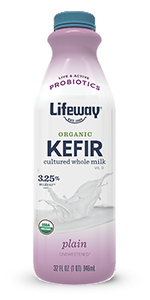This butter is tastier, tangier, and more nutritious than anything you’ll find in the store because it comes from The Kefir Cookbook. Cultured kefir butter has a gorgeous yellow hue because the pastured-raised cows eat grass and flowers, which are rich in beta-carotene, an orange pigment and potent antioxidant.
Cultured Dairy: The Nutrition Benefits You Actually Need to Know
With increasing research linking the correlation between probiotics, gut health, and immunity, it’s no secret that the integrity of our gut is vital to our health. Although additional factors such as stress, antibiotic usage, and individual health conditions can contribute to the condition of our gut, a focus on healthy food choices is one of the easiest ways to support the microbiome.
Several studies have shown a strong association between the gut-brain-microbiota. Probiotics introduced to the gut have been found to support immunity, improve allergies, and improve digestion.
Studies have shown that reduced diversity of healthy gut bacteria during early years is associated with an increase in food allergies during school age years. In addition, kefir made from whole fat milk helps absorb key nutrients such as Vitamins A, D, E, and K. Vitamin K is important because it helps your bones absorb calcium. It’s important to know that kefir contains a special trio: vitamin D, K, and calcium – all three crucial elements to support bone health.
Prebiotics + Probiotics = a Healthy You
Prebiotics are non-living, non-digestible carbohydrates naturally found in a variety of foods. Your body actually can’t digest prebiotics, so they’re what probiotics feed off of to remain actively working in your digestive system. They help the digestive system by promoting the growth of good bacteria. Prebiotics and probiotics work together in balance to make sure our digestive system stays on track and regular. Research has found that consuming a variety of prebiotic and probiotic food sources may improve your body’s natural functions, including both your immune and digestive system.
Servings: 1 CupIngredients
- 1/2 cup Organic Plain Whole Milk Kefir
- 1 quart heavy whipping cream (32-36% butterfat)
Directions
- In a large bowl or food processor, combine the cream and kefir. Cover it with a kitchen towel and seal using a rubber band around the lip of the bowl.
- Leave the bowl out on the countertop or longer until the cream looks to be thickening; the texture at the top will be similar to sour cream. At this point, place the bowl in the refrigerator to chill for a few hours or overnight.
- Once the mixture is cold, mix it in with a stiff whisk, or use the paddle attachment of your stand mixer on high.
- The mixture should turn to whipped cream fairly quickly. Keep whipping until the mixture starts to separate and the fatty part turns yellow.
- Once the liquids are fully separated, drain the butter in a fine-mesh strainer set over a bowl. **
- Work the drained butter with your hands on a cutting board or piece of marble for a minute or two like you would when kneading bread dough; this will smooth the butter and release any more liquid.
- The final product is your kefir butter; store it in a mason jar or wrap it in waxed paper and keep it on the counter in a cool place for months.
- **You can save the liquid for baking or sipping; it will taste like buttermilk and is full of live and active cultures.

